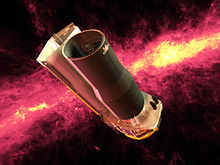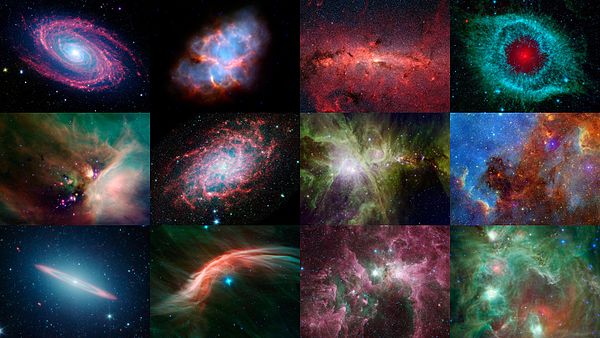Spitzer space telescope
The Spitzer Space Telescope (engl. Spitzer Space Telescope , SST) before, SIRTF (of English. Space Infrared Telescope Facility called), is a after astrophysicist Lyman Spitzer called infrared telescope . It was launched on August 25, 2003 under the name SIRTF with a Delta II 7920H-9.5 rocket from Cape Canaveral and then renamed. It is next to the Hubble Space Telescope , the Chandra X-ray Observatory and the Compton Gamma Ray Observatory part of the Great Observatory Program of NASA . Spitzer was designed for a lifespan of five years and should work for at least two and a half years. The main mission of the space telescope ended in mid-May 2009 when the coolant for the detectors, which had originally been cooled down to 2 K (−271 ° C), was used up. After the temperature had risen to 31 K (−242 ° C), only the two short-wave channels of the infrared camera IRAC could be used. The telescope was switched off on January 30, 2020.
Structure and Mission
In the infrared range examined by the Spitzer telescope, u. a. astrophysical knowledge gained on protoplanetary disks and processes in the formation of planetary systems . The mission should also benefit the understanding of brown dwarfs , infrared galaxies , active galactic nuclei and the processes in the early universe .
The infrared range covered by the Spitzer Space Telescope is between 3 and 180 µm . This part of the electromagnetic radiation enables insights into regions through which no visible light can penetrate. However, the earth's atmosphere for its part largely prevents the infrared radiation from penetrating and therefore cannot be observed with earth-based telescopes. The telescope consists of a 0.85 m main mirror and a smaller second mirror made of beryllium . There are three instruments on board as detectors:
- IRAC (from Infrared Array Camera ), four infrared cameras that could simultaneously record four channels with wavelengths of 3.6 µm, 4.5 µm, 5.8 µm and 8 µm. The field of view was 5.12 ' × 5.12' and the resolution was 256 × 256 pixels.
- IRS (from Infrared Spectrograph ), an infrared spectrometer with four sub-modules that cover the wavelength ranges from 5.3 to 14 µm (low resolution), 10 to 19.5 µm (high resolution), 14 to 40 µm (low resolution) and 19 to 37 µm (high resolution) covered.
- MIPS (from English Multiband Imaging Photometer for Spitzer ) consists of three detector fields in the far infrared range (128 × 128 pixels at 24 µm, 32 × 32 pixels at 70 µm, 2 × 20 pixels at 160 µm) that contain not only images but also spectroscopic data could deliver. The field of view varied between 5 '× 5' for shorter wavelengths and 5 '× 0.5' for longer wavelengths.
To disturbing heat radiation to prevent the infrared detectors, which are telescopic and the instruments with a helium - cryostat to a temperature as close to the absolute zero cooled (5.5 K). In order to avoid disturbing heat radiation from the earth, the telescope does not move in an earth orbit , but in a heliocentric orbit following the earth's orbit; so it is not an earth satellite. This will slowly move the telescope away from Earth. The solar module and heat shields shielded the telescope from heat radiation from the sun and the warmer parts of the space probe .
On May 15, 2009 the liquid helium was used up, causing the temperature to rise to 30K. As a result, the cold mission ended and the warm mission began, which meant limited functionality. Only two of the four IRAC cameras could still be operated.
With the unexpectedly long duration of the Spitzer telescope's mission, the distance to Earth increased, so that the connection became worse and worse. For communication, Spitzer's "back" had to point to the earth. Since, from Spitzer's point of view, the sun was no longer next to Spitzer in this position, the heat protection was not optimally aligned. At the same time, the angle for the solar panels also became less favorable. To maintain communication, Spitzer directed the antennas to earth once or twice every 24 hours and sent data to the Deep Space Network . The communication times could be kept as short as possible. The observation plan was updated once a week.
The beyond phase has been running since October 1, 2016 . Spitzer was looking for objects for closer observation and in this phase paved the way for his successor, the James Webb Space Telescope (JWST). Numerous objects were observed that were not planned at the beginning of the mission and for which the telescope was not originally built. So should exoplanets and the supermassive black hole Sagittarius A * at the center of the Milky Way can be observed. This phase was originally supposed to last until the start of the JWST. However, after the JWST was delayed by several years, the decision was made to switch off the Spitzer telescope at the end of January 2020. The shutdown date was January 30, 2020.
successes
NASA's Michael Werner said that operation was never planned 13 years after launch and that discoveries had been made for which the telescope was never intended.
- In autumn 2005, after filtering out the interference signals from nearby galaxies, a picture of the early universe was obtained from a recording in the constellation Dragon , which - in accordance with current theories - shows the clustering of early stars (see Big Bang , Millennium simulation ).
- At the beginning of 2006, through the combination of several thousand individual images, one received an unprecedented insight into the center of our Milky Way , which is hidden in visible light (Hubble Space Telescope) by interstellar dust .
- With the help of images from October 2006, it was possible to create a relatively detailed temperature map (similar to the image of a thermal imaging camera ) of HD 189733b in the following months .
- May 2007: Within a very short time, Spitzer has tracked down many thousands of previously unknown dwarf galaxies. The discovery was made in the Coma galaxy cluster 320 million light years away.
- At the beginning of 2008, a protoplanetary disk made of organic material was found at AA Tauri and methane gas was found in the atmosphere of exoplanet HD 189733b . Such verifications of organic material on astronomical objects, which are extremely valuable for astronomy and cosmochemistry , can be obtained with the help of IR spectroscopy , similar to analysis and chemistry .
- After no water could be detected in the atmosphere of HD 189733b in February 2007, water vapor was found shortly afterwards in July 2007 . In December 2008, Spitzer delivered "the best evidence to date" for water outside of our solar system on this planet.
- In December 2008, an impressive image showed the destruction of protoplanetary disks of newly formed stars by the solar winds of other massive stars.
- In October 2009 it became known that a new, huge, extremely thin ring made of pieces of ice and dust had been discovered around the planet Saturn in May .
- In March 2010, two prehistoric, primitive black holes were discovered 12.7 billion light years from Earth . One theory states that primeval black holes or quasars are not surrounded by a dust torus, as is the case with quasars that formed much later after the Big Bang . This discovery supports the theory that the two black holes are not surrounded by dust.
- In July 2010, fullerenes were detected in space for the first time by the telescope . This was done through infrared images in the planetary nebula Tc 1 . These are thus the largest detected molecules in space .
- In July 2012, US researchers discovered the planet UCF-1.01 through the telescope, 33 light-years away . Its size is said to be two thirds of the earth and its surface temperature is 600 ° C.
See also
Other space telescopes from the "Great Observatory Program" (all earth satellites):
Other infrared space telescopes:
- IRAS
- ISO
- Herschel
- James Webb Space Telescope (planned)
literature
- L. Armus, WT Reach: The Spitzer Space Telescope: New Views of the Cosmos . Astronomical Society of the Pacific, San Francisco 2006, ISBN 978-1-58381-225-9 .
- George H. Rieke: The Last of the Great Observatories - Spitzer and the Era of Faster, Better, Cheaper at NASA. The University Of Arizona Press, Tucson 2006, ISBN 978-0-8165-2558-4 .
Web links
- Spitzer - The last of the great telescopes
- Project website Spitzer Space Telescope (English)
- Mission overview of the SIRTF at the Jet Propulsion Laboratory (English)
- SIRTF's Orbit (English)
Individual evidence
- ↑ Lyman Spitzer Jr. Denise Applewhite, Princeton University, accessed August 20, 2014
- ↑ a b Tony Greicius: How NASA's Spitzer Has Stayed Alive for So Long. June 12, 2019, accessed January 22, 2020 .
- ^ Store-and-Dump Telemetry - NASA Spitzer Space Telescope. Jet Propulsion Laboratory; California Institute of Technology, accessed May 2, 2017 .
- ↑ a b Tony Greicius: Spitzer Space Telescope Begins 'Beyond' Phase. NASA, August 25, 2016, accessed October 24, 2018 .
- ↑ Stephen Clark: NASA to shut down Spitzer Space Telescope early next year. In: Spaceflight Now. May 30, 2019, accessed May 30, 2019 .
- ^ Whitney Clavin: Spitzer Captures Our Galaxy's Bustling Center. Retrieved January 26, 2009 .
- ↑ Stefan Deiters: Stormy winds on HD 189733b. Retrieved January 26, 2009 .
- ↑ Stefan Deiters: Many thousands of galaxies in one go. Retrieved May 28, 2007 .
- ^ FAZ , March 26, 2008, p. N1
- ↑ Stefan Deiters: Drier and dustier than expected. Retrieved January 26, 2009 .
- ↑ Stefan Deiters: Water vapor in a distant atmosphere. Retrieved January 26, 2009 .
- ^ Rainer Kayser: Water in the atmosphere from HD 189733b. Retrieved January 26, 2009 .
- ↑ Stefan Deiters: Planetary embryos live dangerously. Retrieved January 26, 2009 .
- ↑ Whitney Clavin: NASA Space Telescope Discovers Largest Ring Around Saturn. Retrieved October 7, 2009 .
- ↑ Look at the most primitive black holes , astronews.com
- ^ Alan Buis: NASA Telescope Finds Elusive Buckyballs in Space for First Time. Jet Propulsion Laboratory , July 10, 2010, accessed on October 24, 2018 : "We found what are now the largest molecules known to exist in space," said astronomer Jan Cami of the University of Western Ontario, Canada "
- ^ Whitney Clavin: NASA - Spitzer Finds Possible Exoplanet Smaller Than Earth. In: Jet Propulsion Laboratory . July 18, 2012, accessed October 24, 2018 .



